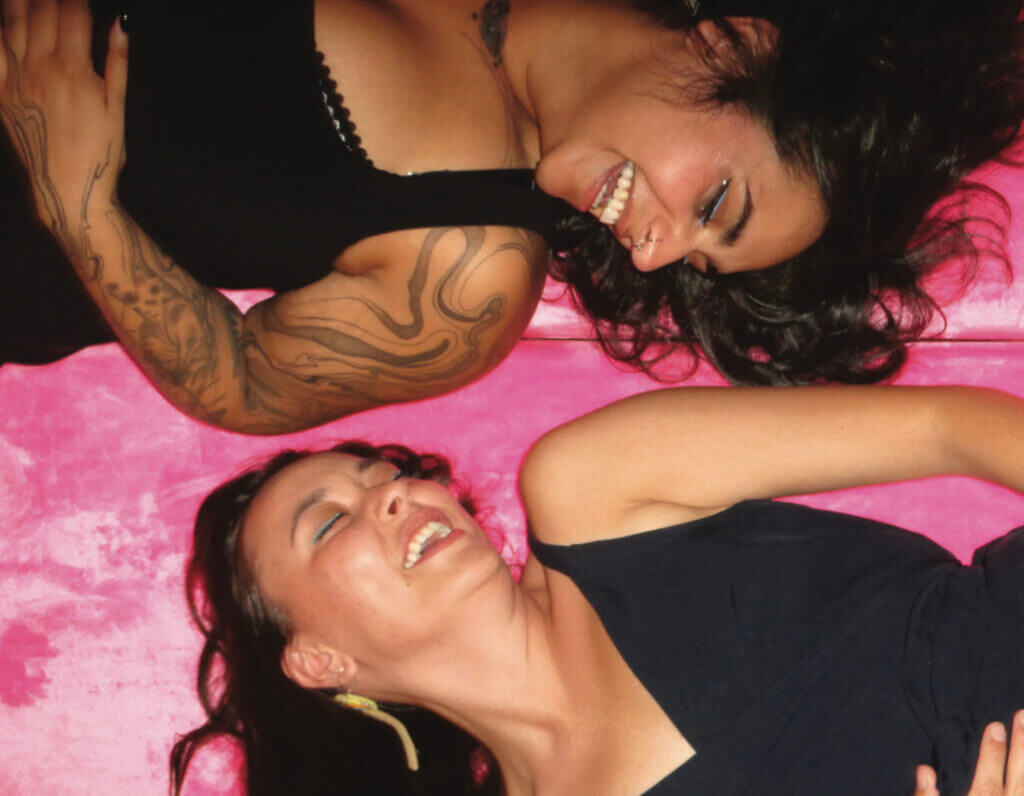A soft space to land
How a peer mentorship collective is helping early-career BIPOC artists
Alexa DiFrancesco

Photo by Britney Supernault
Three years ago, Kiona Callihoo Ligtvoet and Sanaa Humayun were both working as junior employees for art centres whose staff were predominately white. Callihoo Ligtvoet is Cree, Métis, Dutch and mixed European and Humayun is Pakistani; the two friends, who co-hosted a book club together, started to talk about the isolation they felt in their respective spaces as BIPOC artists, and how they felt their agency wasn’t being prioritized. They felt safe with one another, so they shared with each other that they’d faced barriers to access.
“We started having these very real conversations,” Humayun says, “and we realized that what we were doing was peer mentorship.” The product of these conversations was Making Space, a collective that focuses on early-career BIPOC artists and is what Humayun calls “in resistance to the art world at large,” a world which demands that artists produce with aggression. Instead, Amiskwaciwâskahikan-based Callihoo Ligtvoet and Mohkintsis-based Humayun are “two babies who made a group for other babies,” Humayun says, and have created a space of gentleness, which they say is an act of resistance in itself. “We talk about the experiences we’ve had, the people we felt unsafe with, and how to move through those experiences, in a way that’s honest and transparent,” Humayun says.
The collective helps members advocate for fair compensation when freelancing or working in institutional artistic spaces. It’s offered paid skill-sharing workshops, casual in-person hangouts, and hosted speaker events with established artists, who regularly tell Callihoo Ligtvoet and Humayun that they wish there’d been a similar group around when they’d started out. Members collaborated on an art show at McMullin Gallery in Edmonton that’s on through October. The bulk of its community, however, is rooted in its Slack channel of over 100 members, a place to share opportunities, portfolios, and recommended readings.
While there are always projects and plans in the works, the collective doesn’t focus on targeted regular meetups and ongoing deadlines because it’s based in the understanding that members’ capacity to make art and take on new projects can waver. Humayun says that people in the art world speak about community all the time, though often through institutional lenses in which creators’ identities are central to their work. But Making Space is a judgement-free zone, one whose casual drop-in style lets group members choose how much or little to take on and in what capacity to be part of group events.
“So many times Kiona and I say, like, ‘Am I going to take this call from my bed with no pants on? Yeah, probably,’” Callihoo Ligtvoet says. “We all have jobs, we all have families, we all have things that we’re going through. There are times that we’ve been posting events, and we’ve entered it kind of like, ‘I’m exhausted today, I’m feeling really heavy.’ And we leave and feel playful and so happy with the people that [we’re] spending time with. It doesn’t feel extractive.”
The collective’s drop-in style format is about members taking what they need, taking “what feels most relevant.” This way of operating, Callihoo Ligtvoet says, is intentional because the group is working to counteract ideas of exploitation.
“It directly ties into that scarcity mindset of having to produce all the time. So [we keep it] a space where people feel comfortable and there’s nothing owed of them. They don’t have to step into this with obligations, restrictions, or ways that they need to fit,” Callihoo Ligtvoet says.
This process didn’t come easily; it took many virtual and in-person conversations between Making Space community members about supports that they need to take on projects with deliverables, and conversations between Callihoo Ligtvoet and Humayun about keeping the group as low pressure and flexible as possible. Instead of making regular demands on people’s time, Making Space is a cheerleader for its members’ growth, always a soft place to land if they choose to move away and then actively engage again.
“The exciting part of Making Space,” Callihoo Ligtvoet says, “is that it’s always going to shift with us and with the people who still want it.”